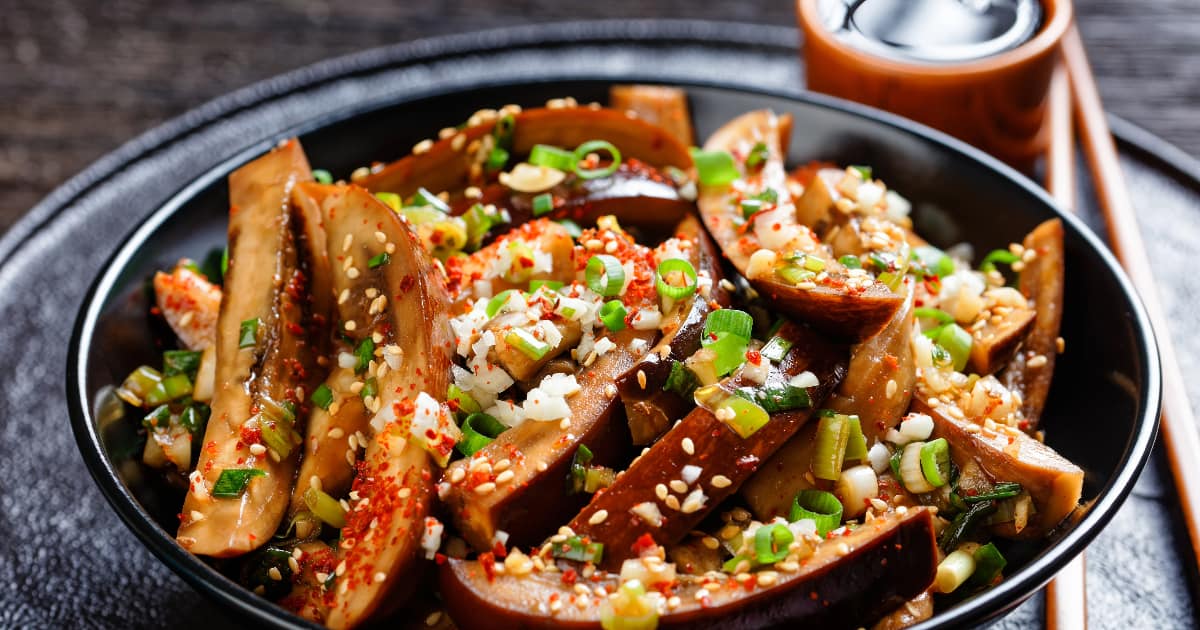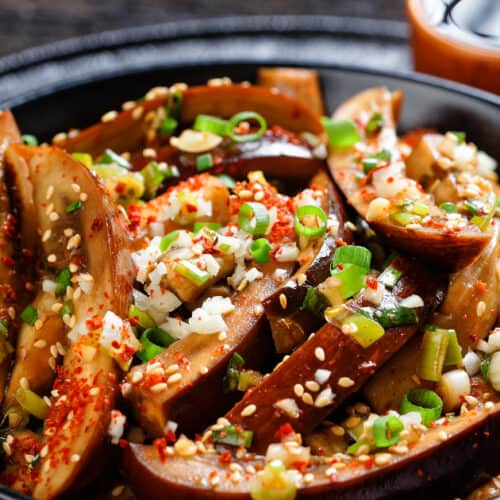The gochujang eggplant recipe produces a delicious Korean-inspired side dish or vegetarian main course. Gochujang is a sweet and spicy fermented Korean chili paste that adds a wonderful depth of flavor. When paired with tender, roasted eggplant, it makes for an irresistible combination.

This recipe only requires a few ingredients and comes together in under 30 minutes. The instructions are straightforward, making this an accessible weeknight meal. While the dish itself is simple, it packs a serious punch of flavor. The eggplant is first roasted to concentrate its flavor and achieve a creamy, soft texture. It is then smothered in a sweet, spicy, and savory gochujang glaze. Scallions, sesame seeds, and cilantro provide freshness and textural contrast.
Keep reading for the complete gochujang eggplant recipe, as well as tips for selecting eggplant and making your own gochujang. This Korean-inspired eggplant is sure to become a favorite!
Selecting Eggplant for Roasting
When selecting eggplant for roasting, choose specimens that are firm and heavy for their size. Avoid eggplants with brown spots or bruising. The shiny, taut skin should be free of blemishes. Smaller, slender Asian eggplants work beautifully for this recipe, as they have thin skin and few seeds. However, you can also use larger globe eggplants if desired.
The variety of eggplant is less important than its freshness. While many recipes call for salting eggplant before cooking to remove bitterness, this step can be skipped with exceptionally fresh eggplant. The eggplant should have a pleasant mild flavor and tender flesh. Roasting concentrates natural sweetness, allowing the complexity of the gochujang glaze to shine.
Step-By-Step Instructions
This easy gochujang eggplant comes together in a few simple steps:
Preheat the oven to 400°F. Line a large baking sheet with parchment paper or foil.
Cut the eggplants lengthwise into long strips or thick rounds. Avoid cutting too thinly, as the eggplant can overcook.
Toss the eggplant with olive oil and spread in a single layer on the prepared baking sheet. Roast for 15-20 minutes until lightly browned.
While the eggplant roasts, prepare the glaze. Whisk together the gochujang, soy sauce, mirin, brown sugar, sesame oil, and garlic.
When the eggplant is tender, coat it generously with glaze. Return it to the oven for 5 more minutes.
Finish with chopped scallions, cilantro, and sesame seeds. Serve immediately over steamed white rice.
Serving Suggestions
This gochujang eggplant is delicious on its own, but also pairs well with:
- Steamed white or brown rice
- Sautéed greens like spinach or bok choy
- Roasted or steamed broccoli
- Quick kimchi or other fermented vegetables
- Tofu or stir-fried meat
- Fried egg for extra protein
For a more complete meal, serve the gochujang eggplant alongside these components. The sweet and spicy eggplant provides the perfect contrast to plain rice and vegetables.
Making Your Own Gochujang
While store-bought gochujang works beautifully in this recipe, you can also make your own for full customization. Homemade gochujang has a fresher, more complex flavor. It also allows you to control the level of heat.
Simmer together rice powder, fermented soybean powder, chili powder, brown sugar, and salt until thickened. Transfer to jars and allow to ferment at room temperature for 1-3 months until deeply flavored. The longer the fermentation period, the more complex the final gochujang paste.
Flavor Variations
Once you master the basic gochujang eggplant recipe, try these tasty variations:
- Swap miso paste for a portion of the gochujang for a Japanese twist
- Add toasted sesame seeds to the glaze
- Use balsamic vinegar and maple syrup instead of mirin and brown sugar
- Mix in minced ginger and garlic for an added kick
- Top with black or white sesame seeds for extra crunch
- Garnish with sliced green onions and chopped peanuts instead of cilantro
- Stir in gochugaru (Korean red pepper flakes) for extra heat
The possibilities are endless, so get creative with the ingredients you have on hand!
Tips for the Best Results
Follow these tips for foolproof, flavorful gochujang eggplant every time:
- Use fresh, in-season eggplants for sweetness - older eggplants can be bitter
- Cut eggplant thickly so it doesn't overcook while roasting
- Roast eggplant thoroughly until completely soft and golden
- Stir the glaze well before using to distribute ingredients evenly
- Coat eggplant generously with glaze and broil to caramelize
- Sprinkle on toppings just before serving to preserve crunch
- Serve immediately while eggplant is hot and crispy
With juicy roasted eggplant and a sticky, spicy glaze, this gochujang eggplant is sure to be a hit! The recipe scales up easily for a crowd. Leftovers keep well refrigerated for 4-5 days. Reheat leftover eggplant in the microwave or oven before serving.
Nutrition Information
This vegetable-based gochujang eggplant is packed with nutrients:
- Eggplant provides dietary fiber, potassium, magnesium, and manganese. The skin is especially high in phenolic antioxidants.
- Gochujang supplies protein along with disease-fighting capsaicin. It also contains probiotics from the fermentation process.
- Scallions and cilantro add vitamin K, vitamin C, and iron.
- Toasted sesame seeds offer calcium, zinc, and healthy fats.
As a meatless main course, this gochujang eggplant provides antioxidants along with anti-inflammatory benefits. Pair it with a source of lean protein and you have a balanced, nutritious meal.
Make Ahead and Storage Tips
While best made fresh and served immediately, you can prepare components of this dish in advance:
- Roast eggplant up to 3 days ahead. Cool, cover, and refrigerate until ready to use.
- Make gochujang glaze up to 4 days ahead. Store covered in the refrigerator.
- Chop scallions, cilantro, and sesame seeds a day in advance. Keep them refrigerated in separate containers.
To serve, reheat roasted eggplant briefly in the oven or microwave. Coat with glaze and finish with fresh herbs and sesame seeds.
Leftover gochujang eggplant keeps well refrigerated for 4-5 days. The flavors meld and improve over time. Reheat portions as needed in the oven or microwave and adjust glaze consistency by stirring in water as needed.
Frequently Asked Questions
What kind of eggplant works best for this recipe?
Slender Asian varieties like Chinese or Japanese eggplants are ideal. Their skin is thinner and they contain fewer seeds, making them less likely to be bitter. However, small Italian eggplants or Thai eggplants would also work well. Choose eggplants that feel heavy for their size with shiny, taut skin.
Can I use pre-made gochujang sauce instead of paste?
It's best to use gochujang paste, which has a thicker, more concentrated flavor. The paste consistency helps the glaze stick to the eggplant. Ready-made gochujang sauce for dipping tends to be thinner with more added sweeteners. The flavor won't have as much depth.
What's the best way to roast the eggplant?
Roasting achieves that luscious, tender texture. Cut eggplant into thick rounds or spears so it doesn't overcook. Roast at 400°F on parchment-lined baking sheets until browned and completely soft when pierced with a fork. Turn halfway through for even cooking.
Can I prepare the components ahead of time?
Absolutely! You can roast the eggplant up to 3 days in advance and refrigerate until ready to use. The glaze also kept for up to 4 days refrigerated. Prepare fresh herb garnishes right before serving to preserve crunch.
What's the best way to reheat leftovers?
Leftover gochujang eggplant holds up well for 4-5 days refrigerated. The flavors meld and improve over time. Reheat portions briefly in the microwave or oven until warmed through. You can also stir in a splash of water to adjust the glaze consistency as needed.
Conclusion
From selecting the eggplant to making the addictive gochujang glaze, this easy yet complex-flavored recipe comes together in a flash. With juicy, tender roasted eggplant smothered in a sweet, spicy, and umami-rich Korean glaze, it makes for a satisfying meatless meal. Keep leftovers refrigerated to enjoy again later in the week. This new favorite is sure to earn a permanent spot in your regular recipe rotation!

Gochujang Eggplant
Ingredients
- 2 pounds Asian eggplant, cut into 1-inch thick rounds
- 3 tablespoons olive oil, for roasting
- 1/4 cup gochujang (Korean chili paste)
- 2 tablespoons soy sauce
- 1 tablespoon brown sugar
- 1 tablespoon rice wine vinegar
- 1 teaspoon toasted sesame oil
- 2 cloves garlic, minced
- 2 scallions, thinly sliced
- 1/4 cup chopped toasted peanuts
- 1/4 cup chopped fresh cilantro
Instructions
- Preheat oven to 400°F. Place eggplant slices on a parchment-lined baking sheet. Brush both sides with olive oil and roast for 15-20 minutes until completely tender.
- In a small bowl, whisk together the gochujang, soy sauce, brown sugar, vinegar, sesame oil, and garlic until smooth.
- Remove eggplant from oven and thickly coat with glaze on both sides. Return to oven for 5 more minutes.
- Transfer glazed eggplant to a platter. Top with scallions, peanuts, and cilantro. Serve immediately over steamed rice.

